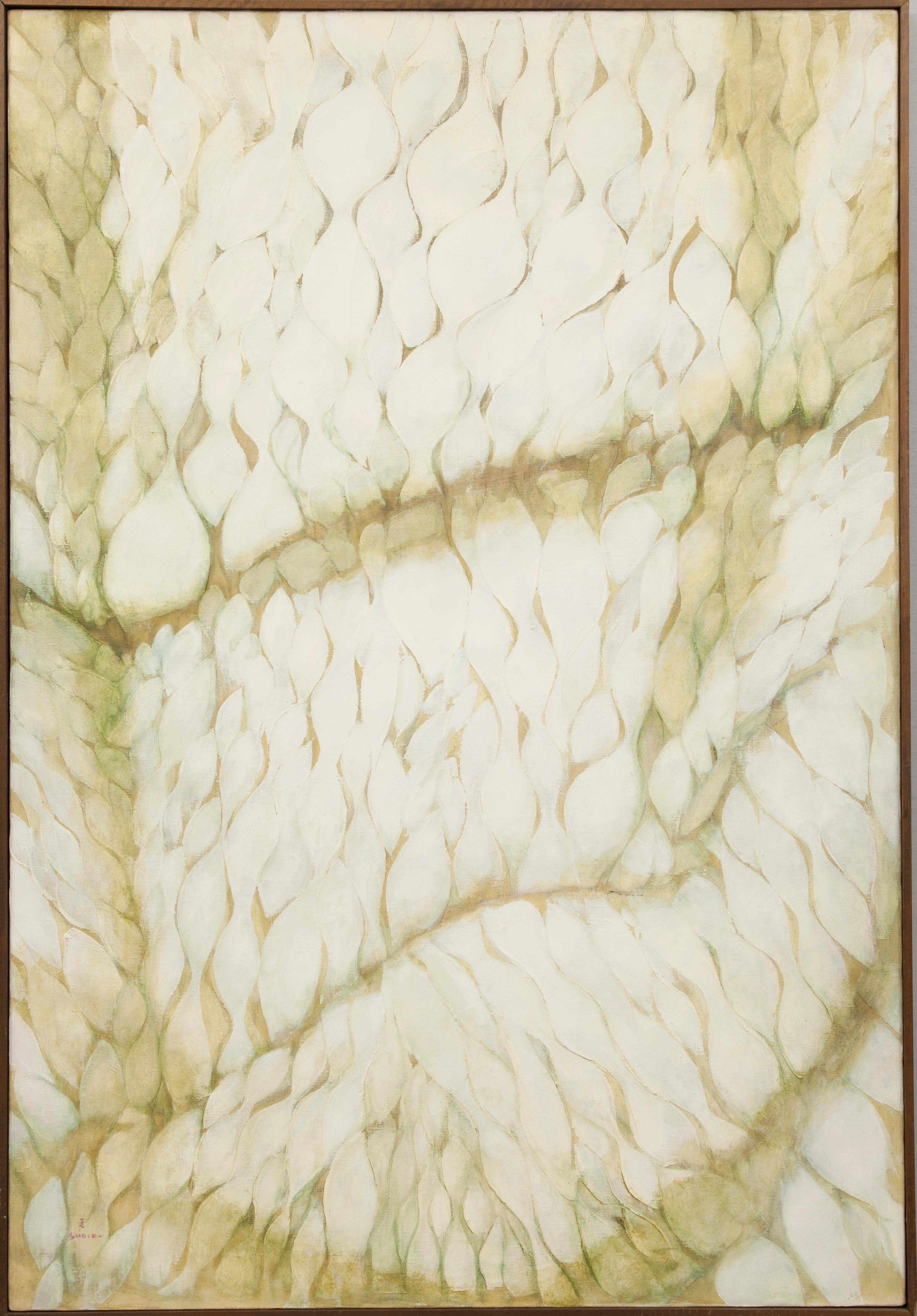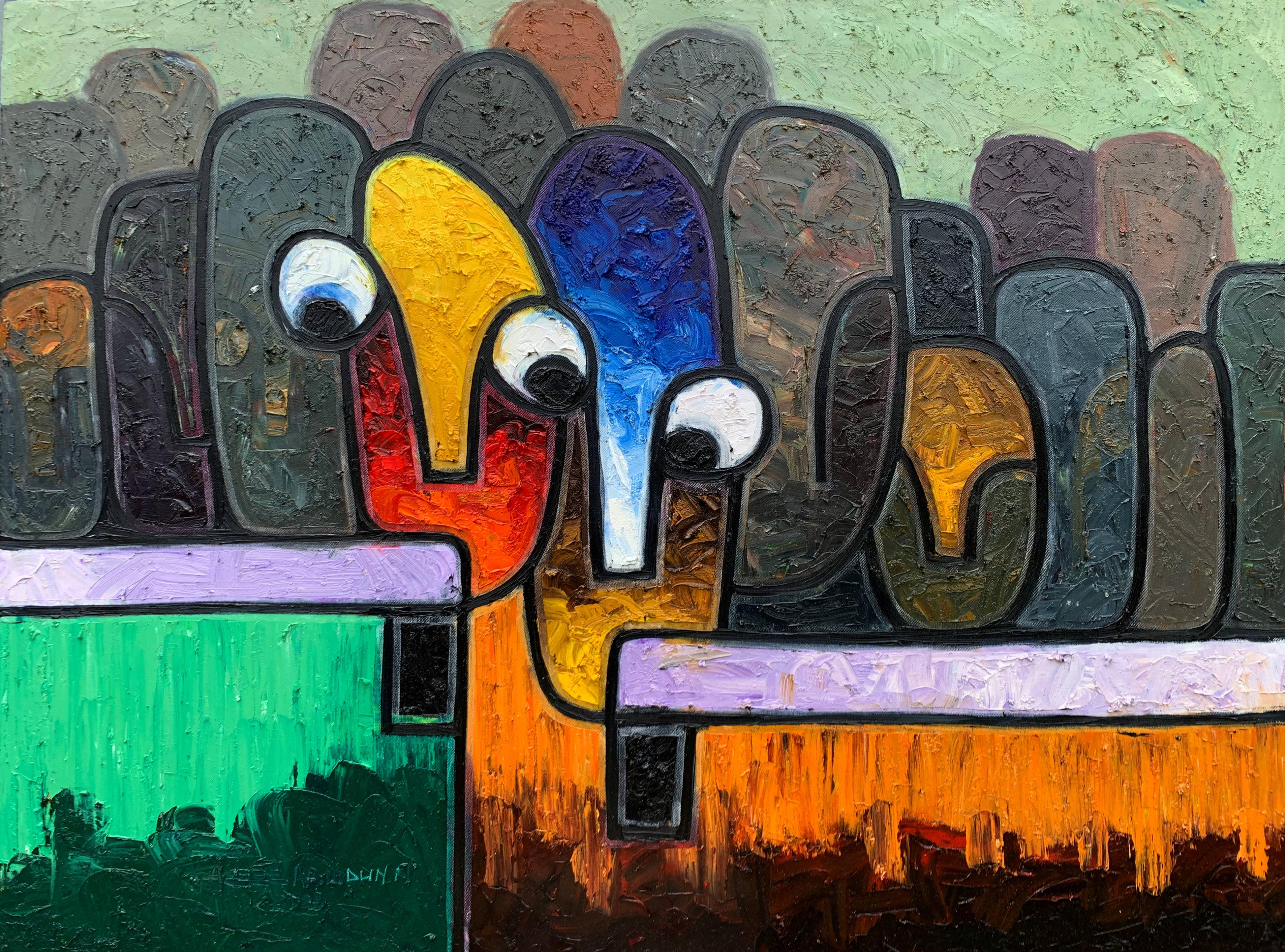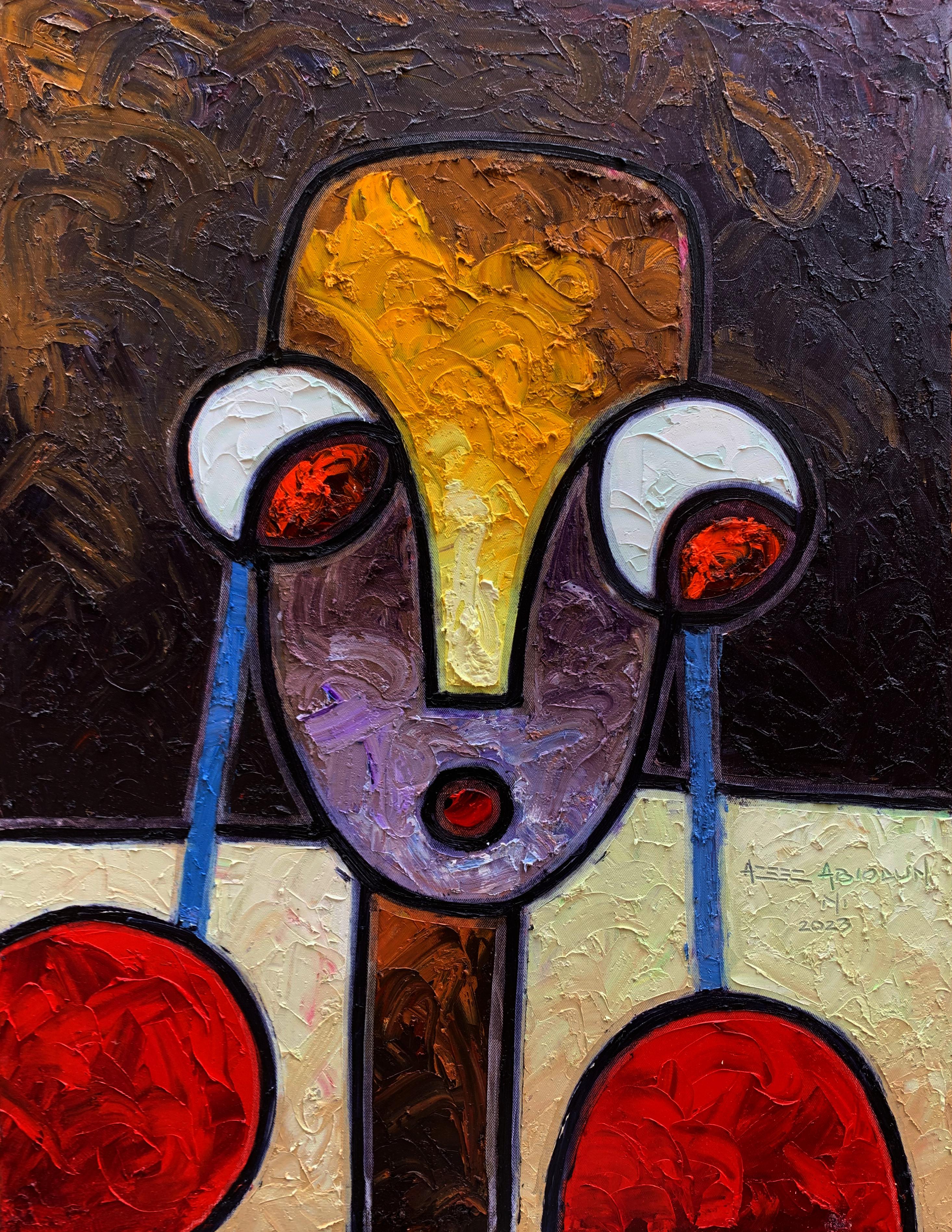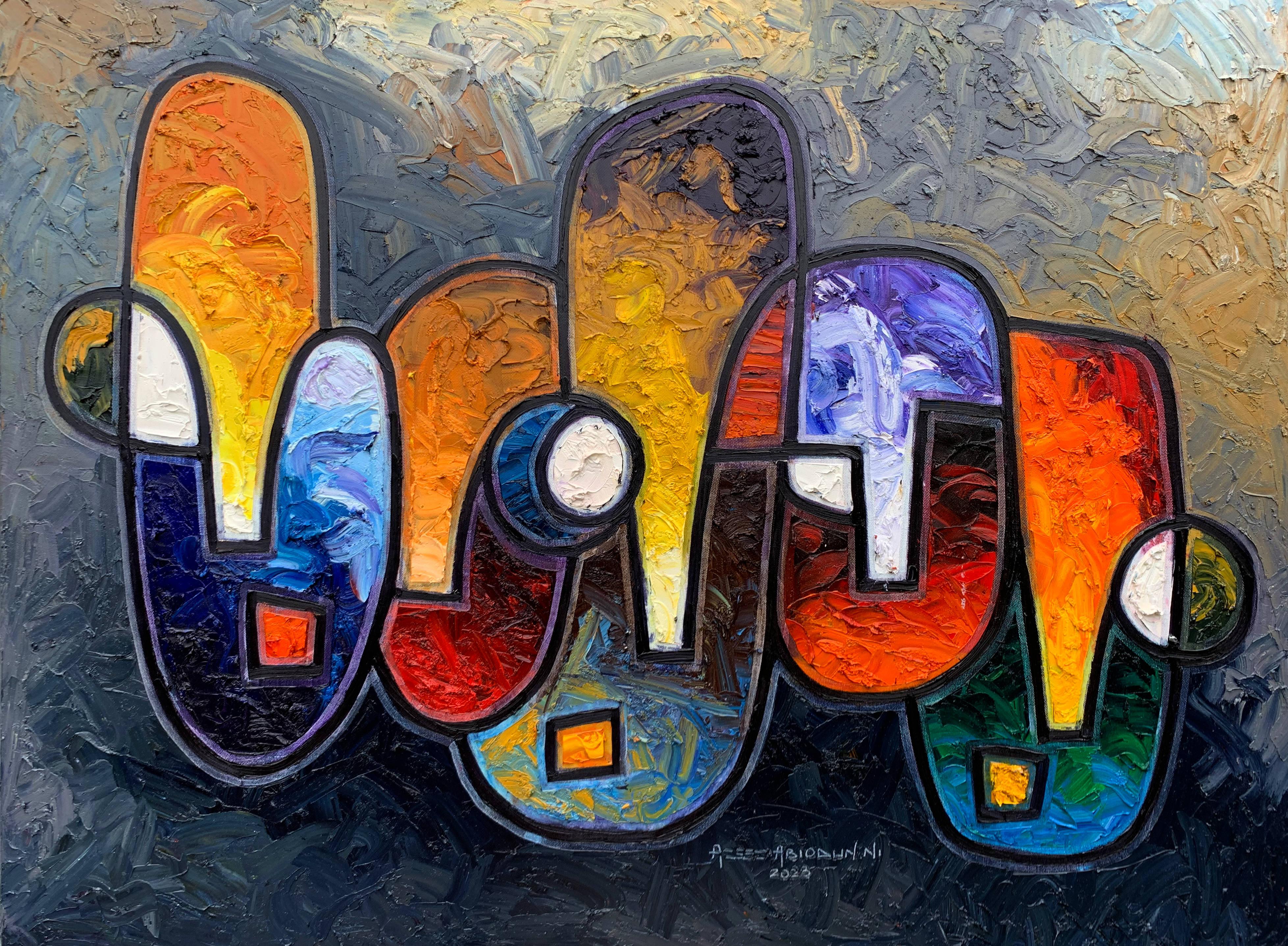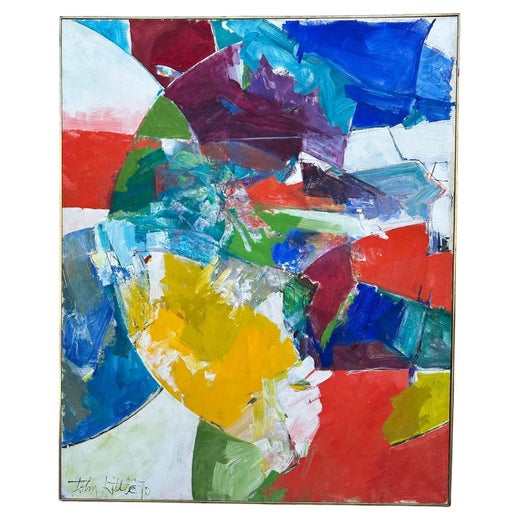Items Similar to “Untitled”
Want more images or videos?
Request additional images or videos from the seller
1 of 11
John Little“Untitled”1965
1965
About the Item
Original oil on canvas painting by the well known abstract expressionist artist, John Little. Signed lower right. Signed and dated 1965 on top stretcher bar verso. Betty Parsons Gallery stamp verso on top stretcher bar. Betty Parsons Gallery was a very well known modern art gallery in New York City established in 1946. Condition is good. The painting is housed in its original period strip wood with brass edge gallery frame in good condition with normal wear consistent with age. Overall framed measurements are 18.75 by 13.5 inches. Provenance: A Palm Beach, Florida estate.
ARTIST BIOGRAPHY
John Little attended the Buffalo Fine Arts academy as a teenager studying with Georg Groz. A multi-disciplinary artist, Little found it hard to decide which of his talents to pursue. He had an operatic voice, became a very successful textile designer creating a flourishing business designing fabrics. After closing the textile business, it became evident that Little's love was painting powerfully gestural works filled with boldly explosive colors. While Little's early style had a linear quality inspired by Surrealism, his later works featured thick impasto and gestural brushstrokes.
After the war John Little returned to New York and with nowhere to stay, was allowed to move into Hans Hofmann's studio where his neighbors were Lee Krasner and Jackson Pollock. Although John Little was not restrained in his painting experimentation, he had a growing interest in Surrealism and the works of Picasso. Little's primary influence was the color and creative theory of Hans Hofmann; who was without doubt the most influential teacher in American history. In 1946 Little held his first one man show at the California Palace of the Legion of Honor in San Francisco, followed by a solo show at Betty Parsons in 1948. In the early 1950's, Little abandoned the flat, linear style of the 40s and progressively painted in thick, gestural paintings with broad strokes of powerful colors. In 1951 he moved to East Hampton, where he maintained a close friendship with Jackson Pollock, leading the two to hold a joint exhibition in 1955 at Guild Hall. In 1957 Little helped found the Signa Gallery, an important outpost in East Hampton for the growing New York art scene and host to many influential exhibitions. Little continued to actively exhibit until his death in 1984.
Little had solo exhibitions at, among others, Betty Parsons Gallery in 1948, Bertha Schaefer Gallery in 1957 and 1958, Worth Ryder Gallery in 1963, A.M. Sachs Gallery in 1971 and a retrospective at the Guild Hall Museum in 1982. His work is part of the permanent collections of The Metropolitan Museum of Art, The Guild Hall Museum, Ball State University Museum of Art, Galerie Beyeler (National Gallery, Basel) , Dillard University, The Bruce Museum and the University Art Museum at Berkeley, CA.
- Creator:John Little (1907-1984, American)
- Creation Year:1965
- Dimensions:Height: 18 in (45.72 cm)Width: 13 in (33.02 cm)Depth: 1.25 in (3.18 cm)
- Medium:
- Movement & Style:
- Period:
- Condition:Several tiny punctures with old repairs. See photo.
- Gallery Location:Southampton, NY
- Reference Number:1stDibs: LU14112065732
John Little
Born in Alabama, John Little attended the Buffalo (NY) Fine Arts Academy as a teenager, until 1927. Soon after, he moved to New York where he began operatic vocal training and opened what would become a very successful textile business designing fabric and wallpaper. In 1933, he enrolled at the Art Students League under the tutelage of George Grosz. Little’s early work consisted predominantly of landscapes, until 1937, when he began studying under Hans Hofmann and his work naturally shifted toward abstraction. During his time with Hofmann, he with artists such as Lee Krasner, George McNeil, Gerome Kamrowski, Giorgio Cavallon, and Perle Fine. Little entered the the service in 1942 as an aerial photographer for the Navy. Returning to New York after the war and with nowhere to stay, he reconnected with Hofmann and moved into his 8th Street studio, alongside his friend Lee Krasner and her husband Jackson Pollock. In 1946, Little earned his first solo exhibition at the California Palace of the Legion of Honor in San Francisco, with a subsequent solo exhibition at Betty Parsons Gallery in New York two years later. In the early 1950s, Little abandoned the flat, linear style in favor of a new aesthetic consisting of the thick, gestural buildup of paint. This stylistic change was concurrent with his move to East Hampton In 1951. This enabled him to continue a close friendship with Krasner and Pollock, who had already left the city in favor of the more rural area around East Hampton. Little and Pollock had a joint exhibition in 1955 at Guild Hall, one year before Pollock’s tragic death. John Little exhibited extensively during his career, with solo shows at Betty Parsons Gallery (1948), Bertha Schaefer Gallery (1957, 1958), Worth Ryder Gallery (1963), A.M. Sachs Gallery (1971), and a retrospective at the Guild Hall Museum (1982). His work can be found in many private, institutional, and corporate collections around the world, including the Metropolitan Museum of Art, Guild Hall Museum, Ball State University Museum of Art, and Galerie Beyeler.
About the Seller
5.0
Platinum Seller
These expertly vetted sellers are 1stDibs' most experienced sellers and are rated highest by our customers.
Established in 1977
1stDibs seller since 2013
467 sales on 1stDibs
Typical response time: 1 hour
- ShippingRetrieving quote...Ships From: Southampton, NY
- Return PolicyA return for this item may be initiated within 7 days of delivery.
More From This SellerView All
- “Abstract, 1954”By Irene ZevonLocated in Southampton, NYOil on canvas abstract painting by the American artist, Irene Zevon. Signed lower right and dated 1954. In very good condition. Not presently framed. Provenance: Estate of the artis...Category
1950s Abstract Expressionist Abstract Paintings
MaterialsCanvas, Oil
- “Lightride”By Syd SolomonLocated in Southampton, NYHere for your consideration is a great example of the artwork of the well known American artist, Syd Solomon. Signed top left. Titled and dated verso 1978. The painting is oil and acrylic paint on mounted synthetic canvas. Condition is excellent. Overall framed measurements are 44.75 by 24.5 inches. Provenance: A Sarasota, Florida collector. SYD SOLOMON BIOGRAPHY American 1917-2004 Written by Dr. Lisa Peters/Berry Campbell Gallery “Here, in simple English, is what Syd Solomon does: He meditates. He connects his hand and paintbrush to the deeper, quieter, more mysterious parts of his mind- and he paints pictures of what he sees and feels down there.” --Kurt Vonnegut Jr. from Palm Sunday, 1981 Syd Solomon was born near Uniontown, Pennsylvania, in 1917. He began painting in high school in Wilkes-Barre, where he was also a star football player. After high school, he worked in advertising and took classes at the Art Institute of Chicago. Before the attack on Pearl Harbor, he joined the war effort and was assigned to the First Camouflage Battalion, the 924th Engineer Aviation Regiment of the US Army. He used his artistic skills to create camouflage instruction manuals utilized throughout the Army. He married Ann Francine Cohen in late 1941. Soon thereafter, in early 1942, the couple moved to Fort Ord in California where he was sent to camouflage the coast to protect it from possible aerial bombings. Sent overseas in 1943, Solomon did aerial reconnaissance over Holland. Solomon was sent to Normandy early in the invasion where his camouflage designs provided protective concealment for the transport of supplies for men who had broken through the enemy line. Solomon was considered one of the best camoufleurs in the Army, receiving among other commendations, five bronze stars. Solomon often remarked that his camouflage experience during World War II influenced his ideas about abstract art. At the end of the War, he attended the École des Beaux-Arts in Paris. Because Solomon suffered frostbite during the Battle of the Bulge, he could not live in cold climates, so he and Annie chose to settle in Sarasota, Florida, after the War. Sarasota was home to the John and Mable Ringling Museum of Art, and soon Solomon became friends with Arthur Everett “Chick” Austin, Jr., the museum’s first Director. In the late 1940s, Solomon experimented with new synthetic media, the precursors to acrylic paints provided to him by chemist Guy Pascal, who was developing them. Victor D’Amico, the first Director of Education for the Museum of Modern Art, recognized Solomon as the first artist to use acrylic paint. His early experimentation with this medium as well as other media put him at the forefront of technical innovations in his generation. He was also one of the first artists to use aerosol sprays and combined them with resists, an innovation influenced by his camouflage experience. Solomon’s work began to be acknowledged nationally in 1952. He was included in American Watercolors, Drawings and Prints at the Metropolitan Museum of Art, New York. From 1952–1962, Solomon’s work was discovered by the cognoscenti of the art world, including the Museum of Modern Art Curators, Dorothy C. Miller and Peter Selz, and the Whitney Museum of American Art’s Director, John I. H. Baur. He had his first solo show in New York at the Associated American Artists Gallery in 1955 with “Chick” Austin, Jr. writing the essay for the exhibition. In the summer of 1955, the Solomons visited East Hampton, New York, for the first time at the invitation of fellow artist David Budd...Category
1970s Abstract Expressionist Abstract Paintings
MaterialsCanvas, Oil, Acrylic, Board
- “Turning”By Syd SolomonLocated in Southampton, NYOriginal oil paint and acrylic paint on canvas by the well known American artist, Syd Solomon. Signed bottom middle. Titled and dated verso, 1977/1978. The location for the painting is Midnight Pass near where the artist once lived in Sarasota, Florida. Condition is excellent. The painting is housed in its original gallery frame with silver edge. Overall framed measurements are 51 by 38 inches. Provenance: A Sarasota, Florida collector. American, 1917-2004 SYD SOLOMON BIOGRAPHY: Written by Dr. Lisa Peters/Berry Campbell Gallery “Here, in simple English, is what Syd Solomon does: He meditates. He connects his hand and paintbrush to the deeper, quieter, more mysterious parts of his mind- and he paints pictures of what he sees and feels down there.” --Kurt Vonnegut Jr. from Palm Sunday, 1981 Syd Solomon was born near Uniontown, Pennsylvania, in 1917. He began painting in high school in Wilkes-Barre, where he was also a star football player. After high school, he worked in advertising and took classes at the Art Institute of Chicago. Before the attack on Pearl Harbor, he joined the war effort and was assigned to the First Camouflage Battalion, the 924th Engineer Aviation Regiment of the US Army. He used his artistic skills to create camouflage instruction manuals utilized throughout the Army. He married Ann Francine Cohen in late 1941. Soon thereafter, in early 1942, the couple moved to Fort Ord in California where he was sent to camouflage the coast to protect it from possible aerial bombings. Sent overseas in 1943, Solomon did aerial reconnaissance over Holland. Solomon was sent to Normandy early in the invasion where his camouflage designs provided protective concealment for the transport of supplies for men who had broken through the enemy line. Solomon was considered one of the best camoufleurs in the Army, receiving among other commendations, five bronze stars. Solomon often remarked that his camouflage experience during World War II influenced his ideas about abstract art. At the end of the War, he attended the École des Beaux-Arts in Paris. Because Solomon suffered frostbite during the Battle of the Bulge, he could not live in cold climates, so he and Annie chose to settle in Sarasota, Florida, after the War. Sarasota was home to the John and Mable Ringling Museum of Art, and soon Solomon became friends with Arthur Everett “Chick” Austin, Jr., the museum’s first Director. In the late 1940s, Solomon experimented with new synthetic media, the precursors to acrylic paints provided to him by chemist Guy Pascal, who was developing them. Victor D’Amico, the first Director of Education for the Museum of Modern Art, recognized Solomon as the first artist to use acrylic paint. His early experimentation with this medium as well as other media put him at the forefront of technical innovations in his generation. He was also one of the first artists to use aerosol sprays and combined them with resists, an innovation influenced by his camouflage experience. Solomon’s work began to be acknowledged nationally in 1952. He was included in American Watercolors, Drawings and Prints at the Metropolitan Museum of Art, New York. From 1952–1962, Solomon’s work was discovered by the cognoscenti of the art world, including the Museum of Modern Art Curators, Dorothy C. Miller and Peter Selz, and the Whitney Museum of American Art’s Director, John I. H. Baur. He had his first solo show in New York at the Associated American Artists Gallery in 1955 with “Chick” Austin, Jr. writing the essay for the exhibition. In the summer of 1955, the Solomons visited East Hampton, New York, for the first time at the invitation of fellow artist David Budd...Category
1970s Abstract Expressionist Abstract Paintings
MaterialsCanvas, Oil, Acrylic
- “Gulfside”By Syd SolomonLocated in Southampton, NYOriginal, oil paint and acrylic paint on canvas by the well known American artist, Syd Solomon. Signed bottom middle by the artist. Titled and dated verso 1983. Condition is excellent. Original gallery floating frame. Overall framed measurements are 38 by 42 inches. Provenance: A Sarasota, Florida collector. SYD SOLOMON BIOGRAPHY Written by Dr. Lisa Peters/Berry Campbell Gallery “Here, in simple English, is what Syd Solomon does: He meditates. He connects his hand and paintbrush to the deeper, quieter, more mysterious parts of his mind- and he paints pictures of what he sees and feels down there.” --Kurt Vonnegut Jr. from Palm Sunday, 1981 Syd Solomon was born near Uniontown, Pennsylvania, in 1917. He began painting in high school in Wilkes-Barre, where he was also a star football player. After high school, he worked in advertising and took classes at the Art Institute of Chicago. Before the attack on Pearl Harbor, he joined the war effort and was assigned to the First Camouflage Battalion, the 924th Engineer Aviation Regiment of the US Army. He used his artistic skills to create camouflage instruction manuals utilized throughout the Army. He married Ann Francine Cohen in late 1941. Soon thereafter, in early 1942, the couple moved to Fort Ord in California where he was sent to camouflage the coast to protect it from possible aerial bombings. Sent overseas in 1943, Solomon did aerial reconnaissance over Holland. Solomon was sent to Normandy early in the invasion where his camouflage designs provided protective concealment for the transport of supplies for men who had broken through the enemy line. Solomon was considered one of the best camoufleurs in the Army, receiving among other commendations, five bronze stars. Solomon often remarked that his camouflage experience during World War II influenced his ideas about abstract art. At the end of the War, he attended the École des Beaux-Arts in Paris. Because Solomon suffered frostbite during the Battle of the Bulge, he could not live in cold climates, so he and Annie chose to settle in Sarasota, Florida, after the War. Sarasota was home to the John and Mable Ringling Museum of Art, and soon Solomon became friends with Arthur Everett “Chick” Austin, Jr., the museum’s first Director. In the late 1940s, Solomon experimented with new synthetic media, the precursors to acrylic paints provided to him by chemist Guy Pascal, who was developing them. Victor D’Amico, the first Director of Education for the Museum of Modern Art, recognized Solomon as the first artist to use acrylic paint. His early experimentation with this medium as well as other media put him at the forefront of technical innovations in his generation. He was also one of the first artists to use aerosol sprays and combined them with resists, an innovation influenced by his camouflage experience. Solomon’s work began to be acknowledged nationally in 1952. He was included in American Watercolors, Drawings and Prints at the Metropolitan Museum of Art, New York. From 1952–1962, Solomon’s work was discovered by the cognoscenti of the art world, including the Museum of Modern Art Curators, Dorothy C. Miller and Peter Selz, and the Whitney Museum of American Art’s Director, John I. H. Baur. He had his first solo show in New York at the Associated American Artists Gallery in 1955 with “Chick” Austin, Jr. writing the essay for the exhibition. In the summer of 1955, the Solomons visited East Hampton, New York, for the first time at the invitation of fellow artist David Budd...Category
1980s Abstract Expressionist Abstract Paintings
MaterialsCanvas, Oil, Acrylic
- “Untitled Abstract”By Nahum TschacbasovLocated in Southampton, NYOriginal mid-century modern abstract oil on canvas painting by the well known Russian/American artist Nahum Tschacbasov. Signed lower right and dated 1945. Condition is very good. P...Category
1940s Abstract Expressionist Abstract Paintings
MaterialsCanvas, Oil
- “Untitled”By John LittleLocated in Southampton, NYEarly, original oil on canvas painting by the well known American abstract expressionist artist, John Little. Signed and dated lower right, 1958. Signed and dated verso. Rose Fried...Category
1950s Abstract Expressionist Abstract Paintings
MaterialsCanvas, Oil
You May Also Like
- Work P. Oil on canvas by Tadashi Sugimata, executed in 1963 (abstract painting)By Tadashi SugimataLocated in Hong Kong, HKTadashi Sugimata (1914-1994) WORK P oil on canvas 162.3 x 112.1 cm (63 3/4 x 44 1/8 in) Executed in 1963 Signed Signed and titled in Japanese in the back This work is accompanied...Category
1960s Abstract Expressionist Abstract Paintings
MaterialsCanvas, Oil
- Space With Pocket 3 . Oil on canvas by Tadashi Sugimata (1963) abstract paintingBy Tadashi SugimataLocated in Hong Kong, HKTadashi Sugimata (1914-1994) SPACE WITH POCKET 3 oil on canvas 162.3 x 112.1 cm (63 3/4 x 44 1/8 in) Executed in 1963 Signed The present artwork has been included in the publicat...Category
1960s Abstract Expressionist Abstract Paintings
MaterialsCanvas, Oil
- Peering Through, multicolored abstract expressionist painting on canvasBy Margaret FitzgeraldLocated in New York, NYI'm interested in the physicality of the painting process, and how this physical process connects me to the messy processes of paint application and decision-making. I'm interested i...Category
2010s Abstract Expressionist Abstract Paintings
MaterialsCanvas, Oil Crayon, Oil, Pencil
- Leader and FollowersLocated in Ibadan, Oyo"Leader and Followers" is a visually striking piece of art that immediately captures the viewer's attention. The artwork, which was created using a combination of oil colors, feature...Category
1990s Abstract Expressionist Figurative Paintings
MaterialsCanvas, Oil
- Crimson AdornmentLocated in Ibadan, OyoShipping Procedure Ships in a well-protected tube from Nigeria This work is unique, not a print or other type of copy. Accompanied by a Certificate of Authenticity (Issued by the Gallery) About Artist Abiodun Nafiu Azeez is an accomplished artist with a diverse background in contemporary painting, particularly Osogbo art. However, his true passion lies in abstract expression, where he seeks to promote African art, culture, and nature. Influenced by his artist father, he paints to preserve memories and connect with broader societal concerns. Abiodun's artistic style is characterized by the abstraction and simplification of human compositions. He employs vibrant oil colors, often focusing on primary colors that transition into secondary and tertiary hues. His subjects stand out against neutral backgrounds, creating a harmonious balance in his paintings. A prominent feature in his works is the use of red, blue, and yellow tones, subtly blended to emphasize form and shape. His artistic journey includes training under renowned bead painting contemporary artist Jimoh Buraimoh...Category
1990s Abstract Expressionist Figurative Paintings
MaterialsCanvas, Oil
- UntitledLocated in Ibadan, OyoShipping Procedure Ships in a well-protected tube from Nigeria This work is unique, not a print or other type of copy. Accompanied by a Certificate of Authenticity (Issued by the Gallery) About Artist Abiodun Nafiu Azeez is an accomplished artist with a diverse background in contemporary painting, particularly Osogbo art. However, his true passion lies in abstract expression, where he seeks to promote African art, culture, and nature. Influenced by his artist father, he paints to preserve memories and connect with broader societal concerns. Abiodun's artistic style is characterized by the abstraction and simplification of human compositions. He employs vibrant oil colors, often focusing on primary colors that transition into secondary and tertiary hues. His subjects stand out against neutral backgrounds, creating a harmonious balance in his paintings. A prominent feature in his works is the use of red, blue, and yellow tones, subtly blended to emphasize form and shape. His artistic journey includes training under renowned bead painting contemporary artist Jimoh Buraimoh...Category
1990s Abstract Expressionist Figurative Paintings
MaterialsCanvas, Oil
